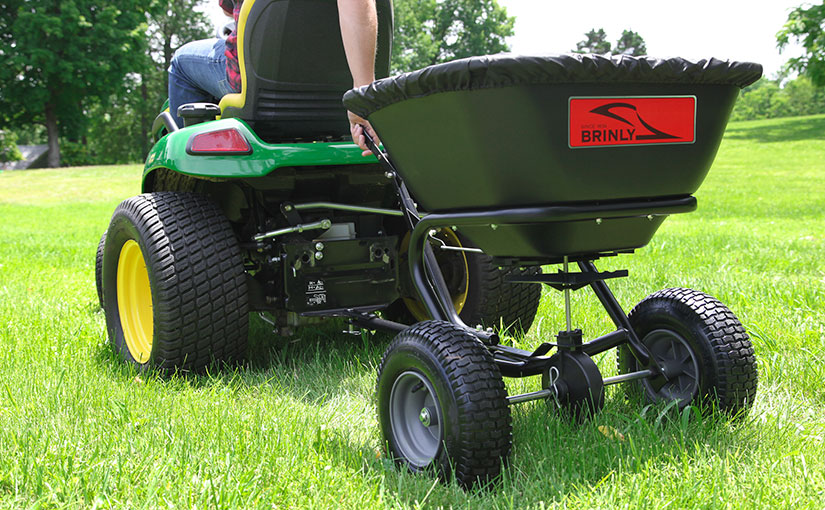If you live in the South, you know that your warm-season grass will soon go dormant, which means you’ll have a brown lawn. Like many homeowners, you want a green lawn to last throughout the winter.
Warm season lawns generally have one of these four grass types:
- Bermudagrass
- Centipedegrass
- St. Augustinegrass
- Zoysiagrass.
You can overseed your warm season lawn with annual or perennial ryegrass to keep your yard green all winter long.
Warm Season Lawns – What’s Happening Underground During Dormancy
As your warm season grass goes into dormancy with the first hint of frost, you’ll notice that the grass’s color will fade from green to a yellow or brown straw-like turf.
Dormant turf doesn’t need as much water or any nutrition at this time. Warm season grasses focus all of their energy on their root system over the winter, where there is a storehouse of moisture and nutrition.
Remember, your dormant lawn may look dead—but it’s only sleeping.
Read more: Spring Flowers to Plant in the Fall
Overseeding Your Warm Season Lawn with Cool Season Grass Seed
You will need to fertilize your warm season lawn 30 days before the first frost, usually in early October. You want a lawn fertilizer that will have more potassium in it as well as nitrogen.
Potassium will harden off cell walls within the grass plant and allow roots to grow deeply. Potassium also helps grass roots to develop more roots and root hairs so the turf can uptake deeper stores of moisture and nutrition throughout the winter.
You also want to plant your annual or perennial ryegrass seed well before the first frost. If you wait too long into the fall season, the grass seed won’t germinate. Most garden centers and big-box stores sell ryegrass seed for warm season lawns.
Make sure that you follow all of the directions on the back of the bag. Also, use a push spreader or tow spreader to broadcast the seed throughout your yard.
When you finish spreading the seed, you want to cover the area with a layer of straw, compost, or topsoil to keep birds from eating the seed.
Annual and perennial ryegrasses adapt to both shade and full sun—that’s why homeowners prefer them over other cool season grasses.
Annual Versus Perennial Ryegrass: Which One Is Better?
Annual and perennial ryegrasses have their pros and cons, depending on your lawn care goals for the winter.
Annual ryegrass pros include:
- It’s less expensive than perennial ryegrass
- It’s short-lived—as soon as it warms up, annual ryegrass will die off
- It helps with erosion control for new lawns before you can plant warm season grasses.
Conversely, annual ryegrass has its cons as well:
- It doesn’t get as green as perennial ryegrass
- It doesn’t grow as thick as perennial ryegrass
- It feels coarser to bare feet when walking on it
- It’s lower quality compared to perennial ryegrass
- It dies off quickly when spring arrives compared to perennial ryegrass.
It looks like perennial ryegrass seed performs better as a lawn grass than its cousin. Typically, farmers use annual ryegrass as an agricultural cover crop over the winter.
Watch more: How to Assemble the Brinly 10 Cu. Ft. Poly Cart (PCT – 10 BH)
Perennial ryegrass’s pros for warm season lawns include:
- It germinates quickly
- Since it’s perennial, it’ll come back each year
- It dies when the temperatures warm up … in time for warm season grasses to start germinating
- It’s a bunch-forming grass, so it grows slowly.
Yet, perennial ryegrass has its detractors too:
- It can live longer in your yard, especially if it’s planted in the shade
- It can become a nuisance grass
- It can’t be a permanent grass because of its susceptibility to lawn diseases during the summer
- It requires a lot of water to live in warmer climates.
Ultimately, you need to decide what type of ryegrass you want to plant in early fall. If you wish for continuous green color throughout the winter, you can choose between annual ryegrass and perennial ryegrass.
How Brinly Hardy’s Push and Tow Spreaders Help You Plant a Beautiful Ryegrass Lawn for Winter
At Brinly Hardy, you’ll find lawn care and garden attachments that help you make short work of all your lawn jobs throughout the growing season.
If you live in the South and have a warm season lawn, you need our push and tow spreaders that broadcast ryegrass seed evenly and efficiently. Use our push and tow spreaders for fertilizing and other yard care jobs.
You can find Brinly products online. If you can’t find any Brinly-Hardy attachments near you, contact our customer service at 877-728-8224 or by filling out our contact form.
Sources:
HGIC.Clemson.edu, “Overseeding with Ryegrass.”
Pennington.com, “All You Need to Know About Perennial Ryegrass.”
SodSolutions.com, “How to Keep Your Lawn Green During Winter.”


